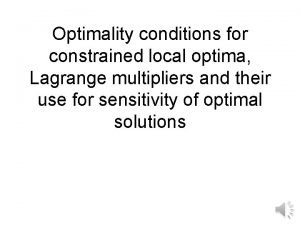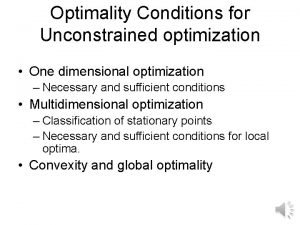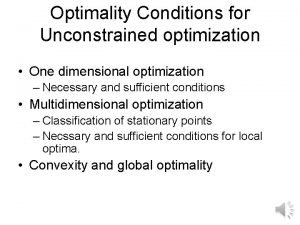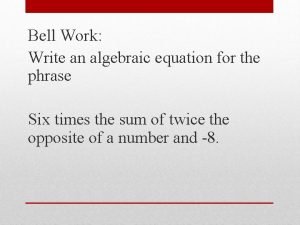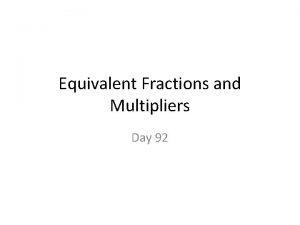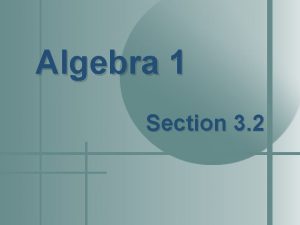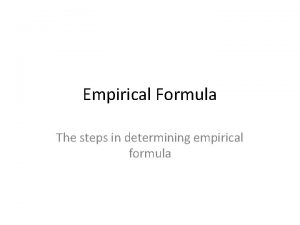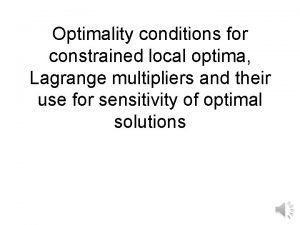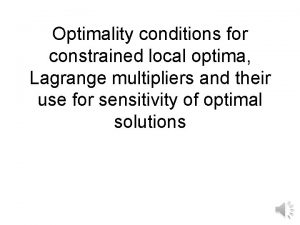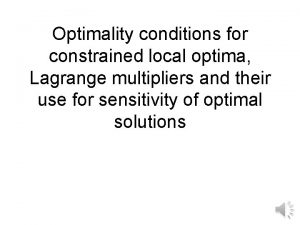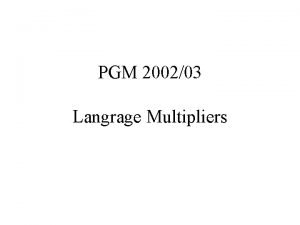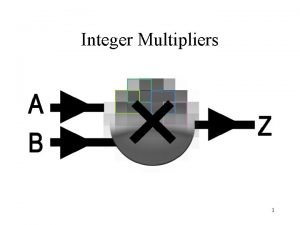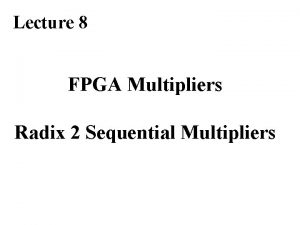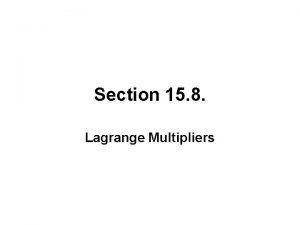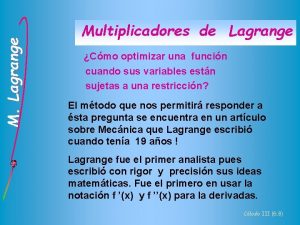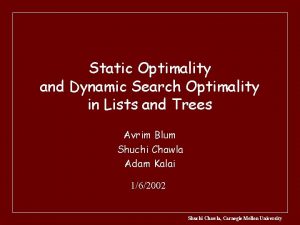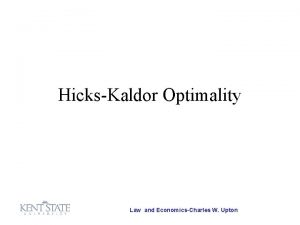Optimality conditions for constrained local optima Lagrange multipliers
















- Slides: 16

Optimality conditions for constrained local optima, Lagrange multipliers and their use for sensitivity of optimal solutions

Constrained optimization • Inequality constraints x 2 g 2(x) g 1(x) Infeasible regions Optimum Decreasing f(x) x 1 Feasible region

Equality constraints • We will develop the optimality conditions for equality constraints and then generalize them for inequality constraints • Give an example of an engineering equality constraint.

Lagrangian and stationarity • Lagrangian function where j are unknown Lagrange multipliers • Stationary point conditions for equality constraints:

Example • Quadratic objective and constraint • Lagrangian • Stationarity conditions • Four stationary points

Problem Lagrange multipliers • Solve the problem of minimizing the surface area of a cylinder of given value V. The two design variables are the radius and height. The equality constraint is the volume constraint. Solution

Inequality constraints • Inequality constraints require transformation to equality constraints: • This yields the following Lagrangian: • Why is the slack variable squared?

Karush-Kuhn-Tucker conditions • Conditions for stationary points are then: • If inequality constraint is inactive (t ≠ 0) then Lagrange multiplier = 0 • For minimum, non-negative multipliers

Convex problems • Convex optimization problem has – convex objective function – convex feasible domain if the line segment connecting any two feasible points is entirely feasible. • All inequality constraints are convex (or gj = convex) • All equality constraints are linear – only one optimum • Karush-Kuhn-Tucker conditions necessary and will also be sufficient for global minimum • Why do the equality constraints have to be linear?

Example extended to inequality constraints • Minimize quadratic objective in a ring • Is feasible domain convex? • Example solved with fmincon using two functions: quad 2 for the objective and ring for constraints (see note page)

Message and solution Warning: The default trust-regionreflective algorithm does not solve …. FMINCON will use the activeset algorithm instead. Local minimum found …. Optimization completed because the objective function is nondecreasing in feasible directions, to within the default value of the function tolerance, and constraints are satisfied to within the default value of the constraint tolerance. x =10. 0000 -0. 0000 fval =100. 0000 lambda = lower: [2 x 1 double] upper: [2 x 1 double] eqlin: [0 x 1 double] eqnonlin: [0 x 1 double] ineqnonlin: [2 x 1 double] lambda. ineqnonlin’=1. 0000 0 What assumption Matlab likely makes in selecting the default value of the constraint tolerance?

Problem inequality • Solve the problem of minimizing the surface area of the cylinder subject to a minimum value constraint as an inequality constraint. Do also with Matlab by defining non-dimensional radius and height using the cubic root of the volume. Solution

Sensitivity of optimum solution to problem parameters • Assuming problem objective and constraints • depend on parameter p • The optimum solution is x*(p) • The corresponding function value f*(p)=f(x*(p), p)

Sensitivity of optimum solution to problem parameters (contd. ) We would like to obtain derivatives of f* w. r. t. p After manipulating governing equations we obtain Lagrange multipliers called “shadow prices” because they provide the price of imposing constraints Why do we have ordinary derivative on the left side and partial on the right side?

Example • A simpler version of ring problem • For p=100 we found • Here it is easy to see that solution is • Which agrees with

Problems sensitivity of optima • For find the minimum for p=0, estimate the derivative df*/dp there, and check by solving again for p=0. 1 and comparing to finite difference derivative. Solution • Calculate the derivative of the cylinder surface area with respect to change in volume using the Lagrange multiplier and compare to the derivative obtained by differentiating the exact solution. Solution
 Constrained nodes and constrained networks
Constrained nodes and constrained networks Scada transport over llns with map-t
Scada transport over llns with map-t Andrea goldsmith wireless communications
Andrea goldsmith wireless communications Lagrange multiplier
Lagrange multiplier Holonomic constraints
Holonomic constraints Optimality conditions for unconstrained optimization
Optimality conditions for unconstrained optimization Optimality conditions for unconstrained optimization
Optimality conditions for unconstrained optimization Two unit multipliers
Two unit multipliers Fraction chain
Fraction chain Unit multipliers
Unit multipliers A 60 g sample of tetraethyl lead
A 60 g sample of tetraethyl lead Binary multipliers
Binary multipliers Introductory chemistry 5th edition nivaldo j. tro
Introductory chemistry 5th edition nivaldo j. tro Magic multiplier
Magic multiplier Calculatort
Calculatort Unit 1 lesson 3 equivalent fractions and multipliers
Unit 1 lesson 3 equivalent fractions and multipliers A* optimality proof
A* optimality proof



